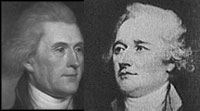 |
||
  |
||
|
|
The First American Party System: Federalists and Democratic-Republicans: The Platforms They Never HadLesson Three of the Curriculum Unit: The First American Party System: Events, Issues, and PositionsGuiding Question
Learning ObjectivesAfter completing this lesson, students will be able to:
IntroductionThe rivalry between the Federalists and Republicans was bitter. Read with the class Jefferson on the Federalists (May 23, 1792) on the EDSITEment-reviewed website American Memory. (NOTE: At this point, avoid discussion of the various issues to which he refers; rather, ask the class to evaluate the tone of the rhetoric. Ask students to identify highly charged words in the passage, such as "corrupt," "vice," "idleness," "corrupting," "monarchy."):… All the capital employed in paper speculation is barren & useless, producing, like that on a gaming table, no accession to itself, and is withdrawn from commerce & agriculture where it would have produced addition to the common mass: That it nourishes in our citizens habits of vice and idleness instead of industry & morality: That it has furnished effectual means of corrupting such a portion of the legislature, as turns the balance between the honest voters which ever way it is directed: That this corrupt squadron, deciding the voice of the legislature, have manifested their dispositions to get rid of the limitations imposed by the constitution on the general legislature, limitations, on the faith of which, the states acceded to that instrument: That the ultimate object of all this is to prepare the way for a change, from the present republican form of government, to that of a monarchy, of which the English constitution is to be the model. That this was contemplated in the Convention is no secret, because its partisans have made none of it.This lesson will point out some of the differences between the parties that caused such strong feelings. The Platform of the Federalists and Democratic-RepublicansThe early Federalists and Democratic-Republicans did not publish party platforms. They had no campaign slogans or posters. In this lesson, students will use statements from members of these parties to create party platforms and if desired, slogans or posters. Designate half the class as Federalists and half as Democratic-Republicans and distribute handouts as follows (see Preparing to Teach This Curriculum Unit for download instructions):To the Federalist group:
AssessmentStudents who have completed this lesson should be able to respond effectively to the following:
Previous lessonReturn to curriculum unit overview: The First American Party System: Events, Issues, and PositionsSelected EDSITEment Websites
Standards Alignment View your state’s standards |
||||||||||||
  |
||
| EDSITEment contains a variety of links to other websites and references to resources available through government, nonprofit, and commercial entities. These links and references are provided solely for informational purposes and the convenience of the user. Their inclusion does not constitute an endorsement. For more information, please click the Disclaimer icon. | ||
| Disclaimer | Conditions of Use | Privacy Policy Search
| Site
Map | Contact
Us | ||
